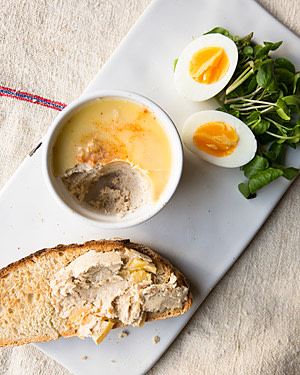Recipe: kipper pâté


Roula Khalaf, Editor of the FT, selects her favourite stories in this weekly newsletter.
Kippers have proved a resilient food. Despite their strong taste and even stronger aroma, those of us who love a good kipper have managed to keep them going. They are still made on the Norfolk and Northumberland coasts, on the Isle of Man and in various other sites dotted around the British coast, and they taste as good as they ever did. There is no better breakfast and, like Bertie Wooster, one is inclined to think they are good for the brain.
Given that kippers are still plentiful, it is surprising how clandestine the business of getting hold of a whole one can be. Everywhere, if offered kipper, one is given fillet. The true kipper lover will know the overwhelming thud of disappointment when the promised kipper turns out to be a couple of miserable little fillets because someone, probably the chef, thinks we cannot be trusted with a whole fish.
My most recent attempt to buy kippers began with a visit to a fishmonger, who had none. I then tried the biggest local supermarket, which produced kipper fillets in a vacuumed bag with butter thoughtfully provided. The next supermarket had fillets on packed ice. I asked, despairingly, of the availability of whole kippers. The young man looked at me appraisingly, winked, disappeared to a cold room and returned with a small box from which he produced the two fine specimens you see photographed here. I felt like a thirsty man in prohibition America who had procured a bottle of proper gin.
I almost kissed him.
Why make such a fuss over whole kippers? There are two reasons. A kipper cooked on the bone has a great deal more succulence, as fillets shrink and dry very easily without the bone to keep them intact. Just as importantly, fillets are cut away from the main backbone, with the result that, paradoxically, a fillet is full of tiny bones which can be lifted away when the fish is cooked on the bone.
Even with a whole kipper, getting rid of these little bones takes a bit of care but it is absolutely essential, whether you are philosophically probing your specimen over a leisurely weekend breakfast or making a kipper pâté.
In a nostalgic moment and in tune with my penchant for reviving forgotten dishes, I decided to put a kipper pâté on the menu when we opened the restaurant six and a bit years ago. Apart from anything else, I was going to put kippers on the menu and thought it would be a prudent economy to process them every couple of days and preserve them. Now I buy kippers just to make the pâté, since what started as a whim has become a stalwart of the menu that I and a good number of my customers would be reluctant to go without.
——————————————-
Kipper pâté
Ingredients
Although they look more attractive on the inside, I always present and tackle my kippers skin side up, as it is easier to peel away the skin and lift the fillets from the bone. Serves six to eight.
2 large kippers
200g unsalted butter
2 lemons
45ml double cream
Cayenne pepper
6 eggs
Watercress
Bread for toasting
● Place the kippers skin side up in a large oven dish. Place 50g of the butter on top. Bake the kippers in a hot oven (200C) for 15 minutes. Allow to cool slightly and pour the rendered butter into a bowl. Very gently peel back the skin and discard it. Edge the fillets apart from the “frame”. The back fillet can be lifted away easily and should have no bone: place with the butter in the bowl. The belly fillet should be turned over and the pin bones gently lifted off. Getting every single piece of bone out is laboursome but important. Once all the filleted meat is off the bone, place it in the bowl and add to it the strained juice of the two lemons, a twist of black pepper and 100g of the butter, softened.
● Place the kipper meat, lemon juice and butter in the food processor and blend until quite smooth. Add the double cream and a pinch of cayenne pepper and blend again until smooth. Check for seasoning – I never add salt in this instance – and then decant the mixture into small ramekins. Smooth the surface of the mixture with the back of a spoon or a small spatula and sprinkle a little cayenne on top.
● Melt the remaining butter in a small pan or microwave. Allow it to cool a little, then pour over the pâtés to create a seal; refrigerate. Serve with hard-boiled eggs, a bunch of watercress and toast. The pâtés will keep for a week in the fridge.
——————————————-
Rowley’s drinking choice
The buttery richness of the pâté suggests any white with sufficient acidity and heft. As a change from my beloved Riesling, perhaps a good Chenin from the Loire would be equally suitable.
Rowley Leigh is the chef at Le Café Anglais
Comments